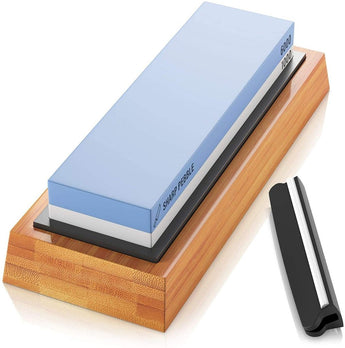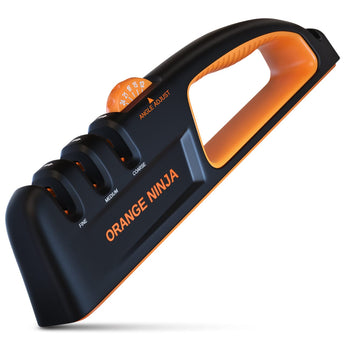Today we’ll discuss the process of burr removal and why must we do it. First, we will briefly explain what is a burr and its purpose to begin with.
What is a burr? A burr, also known as a wire edge, is what we get when we put a metal knife (or other tools such as a chisel) through the sharpening process. The bevels meet each other at the knife’s primary edge; this is where you’ll see burr formation. Burr is essentially the worn-out metal, which we remove from both sides of the primary edge through the act of sharpening.
Proper burr formation tells us if the knife is being sharpened properly. Secondly, burr formation lets you gauge if you have the proper thinness of the blade.
Why is burr removal important? Burr removal is done at the end of the sharpening process while you’re finishing the knife. Proper burr removal plays a vital role in ensuring the proper function of the blade. If you leave out the burr removal process, the raised metal will create unwanted resistance while you cut. This will prevent imparting a smooth incision, impacting the texture of the food you’re handling.
Burr removal process: There are more than one ways to achieve burr removal but we’ll discuss the method most commonly used and easiest for knife burr removal.
Burr removal on water-stone:
-
Once you have sharpened the knife on one side, you’ll feel the burr. To remove it you need to flip the knife to the opposite side and use swiping motions as if you’re sharpening the knife.
-
The only difference this time is that the pressure you apply is a lot less than what you used while you were sharpening (or forming the burr).
-
If you keep a high pressure, you’ll end up creating another burr on the opposite side instead of removing it so make sure to significantly reduce the pressure for burr removal.
-
After a few swipes run your finger on the side of the blade to feel for the burr. If it feels smooth then you have successfully removed the burr.
Micro-burr removal: Microscopic metal can still remain after you have gone over the stone to remove the burr. There are a couple of methods to remove the remaining metal:
-
Leather strop: You need to swipe the knife on each side on a leather strop to be absolutely sure that there’s no burr left.
-
Old newspaper stack: If you don’t have a leather strop lying around, there’s a cheaper and equally effective way to achieve micro burr removal. Get yourself a stack of old newspapers, about a couple of inches high. This will create a comfortable cushion for the knife and ensure that the blade doesn’t get damaged. Swipe the knife (on each side) on the newspaper stack and it will achieve the same effect as the leather strop.





I was watching a older lady cook on Facebook in she took her nap and just ran it real hard through one of those sharpeners that have 2 round circles so I took my good Japanese knife and made tiny cuts on the blade by taking her advice. Dumb me. I sharpened it and found you to help with the burr. Thank you.
I’m a woodturner and we usually take off the burr by dragging the edge of the knife across the end (or side) of a waste block of wood. I use the front corner edge of my wooden workbench.
Thanks so much for the periodic articles. They are really appreciated!
I just wanted to say thank you for this information you have been sending it is very helpful in honing my skills in knife sharpening.
The purpose of the “Burr” on a double beveled knife ..is to ensure that BOTH facets of the bevel equally meet…i.e., the same apex.
My take on this, is to develop a burr on BOTH sides prior to removing the wire edge created…which is the whole purpose of creating a burr in the first place.
In addition, using a “Stack” of newspapers is okay…IF THEY DON’T COMPRESS, to the point of creating a convex edge that’s burnished the actual cutting edge…the very one that we’ve worked so hard to create.
Lastly, in describing the STROPPING (on either leather or newspaper) it should be stressed that the stropping action ALWAYS be edge trailing …this should be specifically pointed out in your descriptive verbiage. You won’t believe the number of people that have asked me about that…I try to politely ask them if they would prefer to CUT their leather strop or strop the edge to remove the burr.
The purpose of the “Burr” on a double beveled knife ..is to ensure that BOTH facets of the bevel equally meet…i.e., the same apex.
My take on this, is to develop a burr on BOTH sides prior to removing the wire edge created…which is the whole purpose of creating a burr in the first place.
In addition, using a “Stack” of newspapers is okay…IF THEY DON’T COMPRESS, to the point of creating a convex edge that’s burnished the actual cutting edge…the very one that we’ve worked so hard to create.
Lastly, in describing the STROPPING (on either leather or newspaper) it should be stressed that the stropping action ALWAYS be edge trailing …this should be specifically pointed out in your descriptive verbiage. You won’t believe the number of people that have asked me about that…I try to politely ask them if they would prefer to CUT their leather strop or strop the edge to remove the burr.